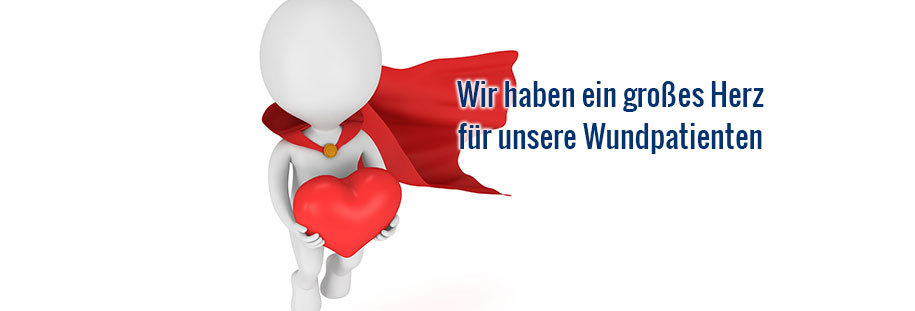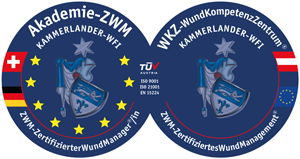 Akademie-ZWM®
Akademie-ZWM®Shop

Wund-Literatur
Nass- / Trockenphase
References
Andriessen, A., Huid en, wondverzorging. In: Van den Brink, G.T.W.J., Lindsen, F., Uffink, Th. (eds) Leerboek intensive-care-verpleegkunde. Lemma BV Utrecht: 2003; 4th edition, Part 2, 25-105
Harding, K.G., Morris, H.L., Patel, G.K. Healing chronic wounds. BMJ 2002; 324: 160-163.
Andriessen, A., Behandelingsmethoden en behandelingsmiddelen. WCS-Nieuws 1988; 4: 2, 7-11.
Falanga, V. Classification for wound bed preparation and stimulation of chronic wounds. Wound Rep Reg 2000; 8: 347-352.
Andriessen, J, Wondbehandeling methodieken en middelen, Pharmaceutisch Weekblad 1991; 126 (3)
Tarnuzzer, R.W., Schultz, G.S. Biochemical Analysis of acute and chronic wound environments.Wound Rep Reg 1996; 4: 321-325.
Grinnell, F., Chin-Han, H., Wysocki, A. Degradation of fibronectin and vitronectin in chronic wound fluid: analysis by cell blotting, immunoblotting, and cell adhesion assays. J Invest Dermatol 1992; 98: 410-416.
Phillips, T.J., al-Amoudi, H.O., Leverkus, M., Park, H.Y. Effect of chronic wound fluid on fibroblasts.
J Wound Care 1998; 7: 10, 527-532.
Kammerlander, G. Lokaltherapeutische Standards für chronische Hautwunden. Springer Verlag, 1998.
Lookingbill, D., Miller, S., Knowles, R. Bacteriology of chronic leg ulcers. Arch Dermatol 1978; 114: 1765-1768.
Gillitzer, R., Goebeler, M. Chemokines in cutaneous wound healing. J Leukocyte Biol 2001; 69: 4, 513-521.
Neilsen, H.J., Werther, K., Mynster, T. et al. Bacterial induced release of white cell and platelet derived vascular endothelial growth factor. Vox Sang 2001; 80: 3, 170-178.
White, R.J., Hothersall, J. The Role of Bacteria in Promoting Wound Exudate; a Hypothesis. Harrogate: Wounds UK, 2002.
Trengrove, N., Langton, S.R., Stacey, M.C. Biochemical analysis of wound fluid from non-healing and healing chronic leg ulcers. Wound Repair Regen 1996; 4: 234-239.
Dow, G., Browne, A., Sibbald, R.G. Infection in chronic wounds: controversies in diagnosis and treatment. Ostomy Wound Manag 1999; 45: 8, 23-42.
Falanga, V., Isaacs, C., Paquette, D. et al. Wounding of bioengineered skin: cellular and molecular aspects after injury. J Invest Dermatol 2002;119: 653-660.
Trengove, N.J., Stacey, M.C., Macauley, S. et al. Analysis of the acute and chronic wound environment: the role of proteases and their inhibitors. Wound Rep Reg 1999; 7: 442-452.
Yager, D.R., Nwomeh, B.C. The proteolytic environment of chronic wounds. Wound Rep Reg 1999; 7: 433-441.
Barrick, B., Campbell, E.J., Owen, C.A. Leukocyte proteinases in wound healing: roles in physiologic and pathologic processes. Wound Rep Reg 1999; 7: 410-422.
Yager, D.R., Chen, S.M., Ward, S.I. et al. Ability of chronic wound fluids to degrade peptide growth factors is associated with increased levels of elastase activity and diminished levels of proteinase inhibitors. Wound Rep Reg 1997; 5: 23-32.
Winter, G. Formation of the scab and the rate of epithelisation of superficial wounds in the skin of the young domestic pig. Nature 1962; 193: 293-294.
Asmussen, P.D., Söllner, B. Wundmanagement Prinzipien und Praxis.Hippokrates Verlag, 1995.
Fleischmann, W., Russ, M., Moch, D. Chirurgische Wundbehandlung. Chirurg 1998; 69: 222-232.
Brunner, U., Eberlein, T. Experiences with hydrofibres in the moist treatment of chronic wounds, in particular of diabetic foot. Vasa 2000; 29: 253-257.
Turner, T.D. Woundauflagen, Wundheilung. 2, wesentlich erweiterte und völlig überarbeitete Auflage. Ed. K.M. Sedlarik. Gustav Fischer Verlag, Jena, 1993.
Hafner, J., Ramelet, A-A., Schmeller, W., Brunner, U.V. (eds). Management of Leg Ulcers. Cur Probl Dermatol. Karger, 1999.
Bowler, P., Davies, B. The microbiology of infected and noninfected leg ulcers. Int Jour Derm 1999; 38: 573-578.
Hansson, C., Hoborn, J., Möller, A., Swanbeck, G. The microbial flora in venous leg ulcers without clinical signs of infection. Acta Derm Venereol (Stockh) 1995; 75: 24-30.
Bowler, P. The anaerobic and aerobic microbiology of wounds: a review. Wounds 1998; 10: 170-178.
Lipsky, B.A. A current approach to diabetic foot infections. Curr Infect Dis Rep 1999; 1: 3, 253-260.
Rodeheaver, G., Baharestani, M.M., Brabec, M.E. et al. Healing and wound management: focus on debridement. An interdisciplinary round table. Adv Wound Care 1994; 7: 1, 22-36.
Rodeheaver, G.T. Pressure ulcer debridement and cleansing: a review of current literature. Ostomy Wound Manage 1999; 45: 1A Suppl, 80S-85S.
Brunner, U. Der diabetische Fuß aus infektchirurgischer Sicht. Zentralbl Chir 1999; 124: 1 Suppl, 13S-16S.
Phillips, D., Davey, C. Wound cleaning versus wound disinfection: a challenging dilemma. Perspectives. Winter 1997; 21: 4, 15-16.
Chisholm, C.D. Wound evaluation and cleansing. Emerg Med Clin North Am 1992; 10: 4, 665-672.
Eich, D., Stadler, R. Differenzierte Lokaltherapie chronischer Wunden. Vasa 1999; 28: 3-9.
Selim, P., Bashford, C., Grossman, C. Evidence-based practice: tap water cleansing of leg ulcers in the community. J Clin Nurs 2001; 10: 3, 372-379.
Barber, L.A. Clean technique or sterile technique? Let's take a moment to think. Wound Ostomy Continence Nurs 2002; 29: 1, 29-32.
McEwan, C. Wound cleansing and dressing. Am J Clin Dermatol 2000; 1: 1, 57-62.
Parker, L. Applying the principles of infection control to wound care. Br J Nurs 2000; 9: 7, 394-396.
Davies, C. Wound care. Cleansing rites and wrongs.Nurs Times 1999; 95: 43, 71-75.
Luedtke-Hoffmann, K., Schafer, D. Pulsed lavage in wound cleansing. Phys Ther 2000; 80: 3, 292-300.
Hollinworth, H. The management of infected wounds. Prof Nurse 1997; 12: 12 Suppl: 8S-11S.
White, C. Wound cleansing. Guidelines for A&E staff. Nurs Times 1997; 93: 2, 46-48.
Trevelyan, J. Wound cleansing. Nurs Times 1996; 92: 50, 44-46.
Barr, J.E. Principles of wound cleansing. Ostomy Wound Manage 1997; 43: Suppl 1, 15S-21S.
Chisholm, C. Wound evaluation and cleansing. Emerg Med Clin North Am 1992; 10: 4, 665-672.
Morison, M.J. Wound cleansing - which solution? Prof Nurse 1989; 4: 5, 220-225.
Whiteside, M.C.R, Moorehead, R.J. Wounds: Biology and Management.Oxford University Press, 1998.
Braddock, M. Wound repair in skin and bone. Sci Med 2002; 8: 218-229.
Görtz, G., Reimer, K., Neef, H. Entwicklung, Eigenschaften und Bedeutung von PVP-Iod. In: Topische Infektionstherapie und Prophylaxe. 1996.
Kramer, A. Antiseptika und Händedesinfektionsmittel. In: Korting, H.C., Sterry, W. (Hrsg) Therapeutische Verfahren in der Dermatologie. Blackwell Wissenschaft, 2001.
Hierholzer, G., Görtz, G. PVP-Jod in der operativen Medizin. Grundlagen, klinische Anwendung und Ergebnisse. In: PVP-Jod in der operativen Medizin, 1984.
Neef, H., Meyer, M., Fischbeck, O. Erfahrungen in der therapeutischen und prophylaktischen Anwendung von PVP-Iod im Thoraxbereich. In:Hierholzer, G., Reimer, K., Weissenbacher, E.R. (Hrsg.). Topische Infektionstherapie und Prophylaxe - Aktueller Stellenwert von PVP-Iod. Thieme,1996.
Stobernack, A., Achatzy, R. Behandlungskonzepte zur Infektionsvermeidung und Therapie infektiöser Komplikationen in der Thorax und Gefäßchirurgie. In:Hierholzer, G., Reimer, K., Weissenbacher, E.R. (Hrsg.). Topische Infektionstherapie und Prophylaxe - Aktueller Stellenwert von PVP-Iod. Thieme,1996
European Tissue Repair Society. Iodine revisited. ETRS Bull 1997; 4: 1, 2-5.
McGuiness, W., Vella, E., Harrison, D. Influence of dressing changes on wound temperature. J Wound Care 2004; 13: 9, 383-385.






